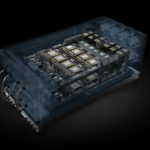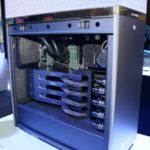In this video, Satinder Nijjar from NVIDIA describes the new DGX-2 GPU supercomputer. “Experience new levels of AI speed and scale with NVIDIA DGX-2, the first 2 petaFLOPS system that combines 16 fully interconnected GPUs for 10X the deep learning performance. It’s powered by NVIDIA DGX software and a scalable architecture built on NVIDIA NVSwitch, so you can take on the world’s most complex AI challenges.”
NVIDIA GPUs Power HPC & AI Workloads in Cloud with Univa
Duncan Poole from NVIDIA gave this talk at the Univa Breakfast Briefing at ISC 2018. “The rise of AI workloads on GPU-enabled systems like RAIDEN in Japan introduces a corresponding and compelling demand for Univa Grid Engine. Aside from being the de facto standard for enterprise-class deployments of shared computational infrastructures for managed HPC and AI workloads, Univa Grid Engine delivers industry-leading integrations with NVIDIA GPUs and Docker containers.”
Video: Researchers Step Up with the New Summit Supercomputer
“The biggest problems in science require supercomputers of unprecedented capability. That’s why the ORNL launched Summit, a system 8 times more powerful than their previous top-ranked system, Titan. Summit is providing scientists with incredible computing power to solve challenges in energy, artificial intelligence, human health, and other research areas, that were simply out of reach until now. These discoveries will help shape our understanding of the universe, bolster US economic competitiveness, and contribute to a better future.”
Supermicro Unveils 2 Petaflop SuperServer Based on New NVIDIA HGX-2
Today Supermicro announced the company is among the first to adopt the NVIDIA HGX-2 cloud server platform to develop the world’s most powerful systems for artificial intelligence and high-performance computing. “To help address the rapidly expanding size of AI models that sometimes require weeks to train, Supermicro is developing cloud servers based on the HGX-2 platform that will deliver more than double the performance,” said Charles Liang, president and CEO of Supermicro. “The HGX-2 system will enable efficient training of complex models. It combines 16 Tesla V100 32GB SXM3 GPUs connected via NVLink and NVSwitch to work as a unified 2 PetaFlop accelerator with half a terabyte of aggregate memory to deliver unmatched compute power.”
Inside the new NVIDIA DGX-2 Supercomputer with NVSwitch
In this video from the GPU Technology Conference, Marc Hamilton from NVIDIA describes the new DGX-2 supercomputer with the NVSwitch interconnect. “NVIDIA NVSwitch is the first on-node switch architecture to support 16 fully-connected GPUs in a single server node and drive simultaneous communication between all eight GPU pairs at an incredible 300 GB/s each. These 16 GPUs can be used as a single large-scale accelerator with 0.5 Terabytes of unified memory space and 2 petaFLOPS of deep learning compute power. With NVSwitch, we have 2.4 terabytes a second bisection bandwidth, 24 times what you would have with two DGX-1s.”
Video: IBM Brings NVIDIA Volta to Supercharge Discoveries
In this video from GTC 2018, Adel El-Hallak from IBM describes how IBM and NVIDIA are partnering to build the largest supercomputers in the world to enable data scientists and application developers to not be limited to any device memory. Between IBM and NVIDIA, you can capitalize on the Volta 32GB memory and the entire system as a whole.
Exxact Corporation offers NVIDIA DGX Station and DGX-1 for Deep Learning
Today Exxact Corporation announced that it will offer the new NVIDIA DGX Station and DGX-1 systems featuring the NVIDIA Tesla V100 data center GPUs based on the NVIDIA Volta architecture. “NVIDIA’s DGX portfolio is paving the way for a new era of computing,” said Jason Chen, Vice President of Exxact Corporation. “The performance of the new DGX Station and DGX-1 systems for AI and advanced analytics is unmatched, providing data scientists a complete hardware and software package for compute-intensive AI exploration.”










